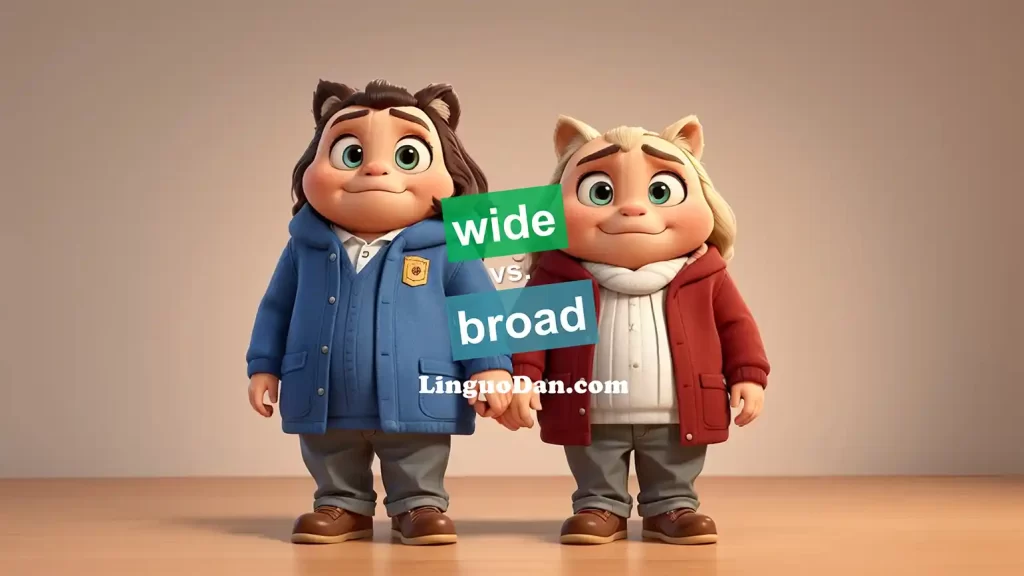Difference between “wide” and “broad”

What is the difference between wide and broad?
The English language is rich with words that may seem synonymous but have subtle differences in meaning and usage. Two such words are “wide” and “broad.” In general, they have the following distinction:
Wide describes the physical width of an object and is often used in the context of specific measurements. For example, a street or river can be wide.
- The street is very wide here.
- She opened her eyes wide in surprise.
Broad is more frequently used to describe abstract concepts, such as ideas and subjects, or to refer to range or variety.
- He has a broad understanding of the subject.
- The discussion covered a broad range of topics.
Thus, “wide” is typically used for physical dimensions, while “broad” can convey extent and describe general characteristics. Let’s examine each word in more detail to understand when to use one over the other.
“Wide” – meaning and usage
“Wide” means broad or expansive in the physical sense, usually indicating a large distance between two sides of an object. It can be used to describe physical dimensions, distances, expanse, and spaces. The word “wide” has several meanings in English. Let’s look at them in detail.
As an Adjective:
The adjective “wide” describes a noun, indicating the width or size of something.
- Broad: Indicating a great distance from one side to the other.
- The table is three feet wide.
- Widespread: Encompassing or reaching across a large number of people or area.
- The news spread wide across the country.
- Far from a target: Not close to an intended point or target.
- His shot was wide of the mark.
As an Adverb:
The adverb “wide” describes a verb, usually indicating the extent to which something is done or happens.
- Fully open: Indicating complete or maximum opening.
- Open your mouth wide.
- Far from a target: Indicating a great distance from a target or aim.
- The ball went wide.
“Broad” – meaning and usage
The word “broad” is also used to describe something that has great width or extent, but it is typically used to refer to large areas or abstract concepts. It can have a more metaphorical meaning, describing scope and diversity.
As an Adjective:
The adjective “broad” describes a noun, emphasizing its width or scale.
- Wide: Indicating a great distance from one side to the other.
- The avenue is very broad.
- General: Covering a wide scope of things; not detailed.
- The book provides a broad overview of the topic.
- Strong accent: If someone has a broad accent, it means their speech has a strong and noticeable accent that shows where they are from.
- He spoke with a broad Scottish accent.
As an Adverb:
- Widely: Used to emphasize that something is open to the full width or occurring over a wide area.
- He smiled broadly.
Collocations with “wide” and “broad”
Collocations are words that are frequently used together with “wide” and “broad”. Knowing these word combinations will help you use the words more naturally in speech.
Examples with “wide”:
- Wide variety: The store offers a wide variety of products.
- Wide range: The program includes a wide range of activities.
- Wide margin: The team won by a wide margin.
- Wide awake: He was wide awake after the loud noise.
Examples with “broad”:
- Broad shoulders: He is known for his broad shoulders.
- Broad range: The library offers a broad range of books.
- Broad spectrum: The medication is effective against a broad spectrum of bacteria.
- Broad consensus: There was broad consensus among the members.
Idiomatic expressions with “wide” and “broad”
Idioms are fixed expressions that have a figurative meaning. Learning such expressions will help you better understand the cultural nuances of the language.
Examples with “wide”:
- Wide of the mark: His assumptions were wide of the mark. (Far from the truth)
- Eyes wide open: He entered the situation with his eyes wide open. (With full understanding)
Examples with “broad”:
- In broad daylight: The theft occurred in broad daylight. (During the daytime)
- A broad mind: She is known for having a broad mind. (Open-mindedness)
Key differences between “wide” and “broad” in English
Both of these words describe something that is broad:
- A wide/broad river
However, there are some key differences in their usage:
- When measuring physical dimensions or distances, “wide” is typically used:
- The river is 100 feet wide.
- There was a six-inch-wide hole in the wall.
- “Broad” is more frequently used to describe abstract concepts, a wide range, or a general overview:
- He has a broad understanding of the topic.
- The book gives a broad overview.
- The word “wide” is mostly applied to physical objects, while “broad” refers to abstract ideas and concepts.
On the other hand, there are idiomatic expressions with “broad”:
- broad shoulders (when a person’s shoulders are far apart from each other)
- in broad daylight (in the open light of day, clearly visible)
- talk or describe something in broad strokes (in a general way, without giving details)
There are also the following idiomatic expressions with “wide”:
- wide open (with a large opening or vulnerability)
- eyes went wide (your eyes became very open)
- a wide range of things (a large and varied number)
- wide of the mark (when an estimate or guess is not accurate)
- far and wide (across a large area).
Although the words “wide” and “broad” may seem synonymous and are both translated as “wide,” their usage depends on the context. “Wide” typically refers to the physical width of objects, while “broad” has a broader (both physical and metaphorical) meaning, often describing scope or variety. Understanding these nuances will help you use these words more accurately and appropriately in English.